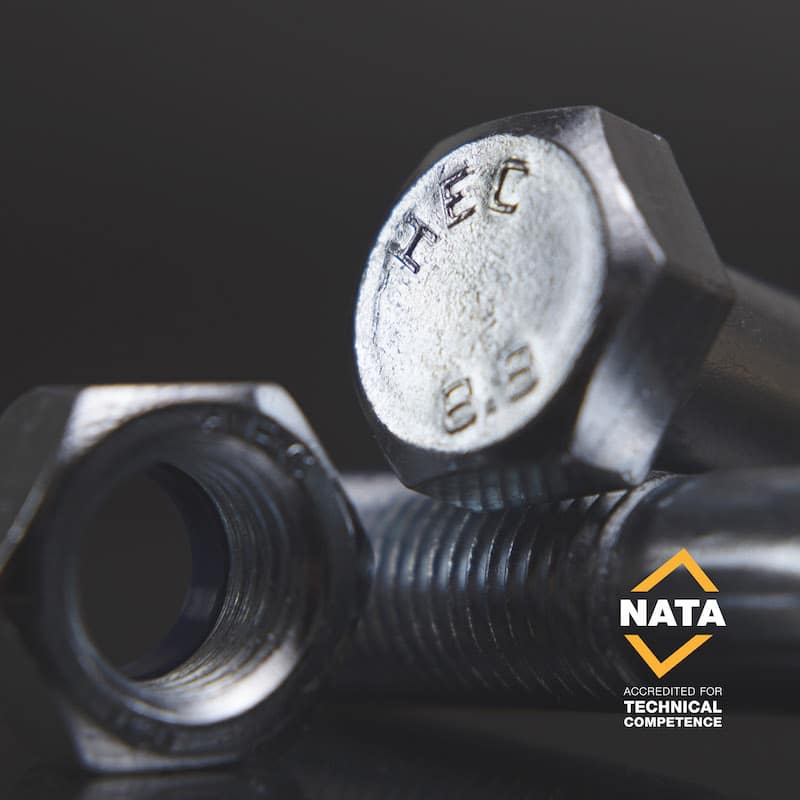Hobson Engineering has developed rigorous fastener testing and verification systems in alignment with Australian standards, taking the lead to forestall substandard imported products entering the Australian construction market.
Curbing the importation of non-conforming construction materials into Australia is a feat that requires the combined effort of construction companies, suppliers and importers alike. While many in the Australian construction industry are still settling for low-cost over quality, given the current cost-driven market, Hobson Engineering is breaking ground by implementing and advocating for efficient quality systems that drive local compliance.

Today, most commercial fasteners in Australia are imported, and with that comes the natural market pressure to reduce costs, leading to global sourcing from regions with varying levels of quality assurance for manufacture. Different products require different levels of testing, and testing and quality control is a major cost to a construction product.
For construction fasteners in Australia, all requirements for quality and design are embedded into the National Construction Code and the product standard. But when a supplier is importing fasteners, how can they ensure those fasteners comply with Australian standards?
Hobson Engineering senior engineer Alex Sharp says all stakeholders in the supply chain of importing, supplying and using construction fasteners, or any other imported construction products, need to scrutinise the product’s quality documentation.
“The net effect of this stakeholder inquiry system is that there are so many people checking that these quality documents are accurate, that the risk of non-confirming fasteners entering the local construction industry is very low,” says Sharp.
“As much as anyone working in or alongside the construction industry would like and expect every single product that they purchase to conform to Australian product standards, without a rigorous checking system of quality documentation to ensure that it is explicitly accurate, the risk of non- conforming product is high.”
To have a robust quality system in place can be a complex process, especially when dealing with fasteners. Hobson Engineering has thousands of lines of products and thousands of locations with pallets of fasteners, and to make sure that suitable testing has been performed is quite an undertaking. But the safety and quality benefits of these testing systems far outweigh the costs.
As Australia moved away from manufacturing and started importing, the construction industry realised many importers weren’t doing their due diligence and checking the quality of the products they were importing.
As a result, Australia changed the standards within the construction industry to clearly define, for all stakeholders, what is expected, which Hobson Engineering has implemented into its product groups.
“The problems associated with mild steel and property class 4.6 products are generally to do with dimensions and coating,” says Sharp. “The quality inspections of these steels are simple in that you can usually use hand tools, such as thread checkers and simple gauges, to check whether it’s a quality, conforming product – importers should be performing random quality checks on these types of products to keep their suppliers honest.”
“Hobson Engineering does regular batch testing, and our warehouses have these tools available to check products as they come in.”

The more complicated products, such as high tensile steel, carry even more quality risk due to the control required to appropriately heat treat the product to the stated tensile strength. The inspection for these products cannot be easily performed with hand tools, and mechanical testing or metallurgic inspection should be performed.
Hobson Engineering conducts mechanical testing on its imported heat-treated threaded fasteners, undertakes routine testing on shipments that arrive and conducts deeper investigations into random product batches.
“We have put this multi-layered testing system in place to not only ensure quality, but to also keep all of our suppliers honest in all facets of the manufacture,” says Sharp.
Hobson Engineering strongly encourages its customers and product end users to consider the inherent risk of the products that they’re buying. All imported products will generally come with a factory test or material certificate, but manufacturers and factories may try to cut costs with quality testing because it’s one of the most expensive elements of product manufacture. If a supplier has imported product and is only relying on a factory test certificate, without any accreditation of verification, there is no way to prove that what’s written on that document is accurate.
One way to verify what is written on a product’s test certificate is to look for International Laboratory Accreditation Cooperation (ILAC) accreditation. ILAC oversees, assesses and accredits conforming testing laboratories to the relevant standards.
“When you receive a test certificate or report from an ILAC accredited testing laboratory, you can trust that systems have been meticulously inspected and that the laboratory is doing the right thing, which means the results are accurate,” says Sharp. “Each country has its own accreditation body recognised under ILAC – in Australia, it’s the National Association of Testing Authorities (NATA).”
Some companies in the past would try and improve quality by putting a blanket ban on importing goods from certain countries, explains Sharp. This normally just increases costs, makes supply more difficult and doesn’t necessarily increase quality. In fact, oftentimes it decreases quality because they’re buying from a cheaper factory in a more expensive region.
Related stories:
“What the purchasers of construction products should be doing is speaking to the suppliers about their particular concerns, and asking what the supplier can provide to prove that the products they’ve imported meet Australian standards,” says Sharp. “The supplier should be able to confidently address any concerns by providing verified documentation, or putting a plan in place, such as a specific inspection or an increased testing regime, to prove that they are thoroughly checking imported product quality.”
“The supplier should be able to create what we call an inspection test plan, which they can give to the customer to outline what they can do to address product quality concerns.
“It’s a better system than putting a ban on the purchase of products from certain countries.”
As an example, Hobson Engineering always recommends increased inspection for any bolts to be used for cranes as the company understands the risks involved in crane operations. Crane bolts are often high tensile, with large diameters, but the product standard is a normal commercial product standard. Hobson Engineering understands that these bolts, which need to support crane operation, are safety critical. If a single bolt on a crane fails, it can result in dire consequences.
“Whenever we sell a product to a crane company or a supplier that deals with crane companies, we put forward a testing plan and highly suggest that they go forward with that testing plan,” says Sharp. “It comes at a small additional cost, but it’s vital to ensure the complete safety and quality of the product.”
“For Hobson Engineering, this testing plan involves us conducting a 100 per cent magnetic particle inspection to ensure that there are no defects in the product and that it meets the Australian product standard.”
Hobson Engineering, as a company, has a multi-faceted approach to inspecting and checking the products it imports and supplies. Its factories are ILAC accredited and audited, and the company has international independent ILAC accredited test laboratories in the countries it purchases its products from, where it sends batches of products for testing. Further adding to the company’s quality control capabilities, Hobson Engineering has its own independent NATA accredited test and research laboratory.
“These three layers of independent testing mean we’re effectively checking the products that we supply,” says Sharp. “All of this testing is integrated into our Quality Management System, which is integrated into our Enterprise Resource Management, meaning there is consistent and effective sampling.”

If a factory sends a sample to a test laboratory, it’s possible that the factory could pick out perfect samples for testing, and then ship over non-conforming product. Hobson Engineering prevents that from happening by keeping its suppliers accountable through its own advanced quality management system.
Because Hobson Engineering has a NATA accredited laboratory locally in Australia, the company can isolate, investigate and resolve issues with products quickly and efficiently.
“We pride ourselves on being a responsible importer and trusted supplier, backed by our rigorous testing systems and commitment to safety and quality,” says Sharp. “We exceed what is required in terms of product quality testing, and thus see ourselves as market leaders in addressing quality issues.”
Hobson Engineering has been supplying quality fasteners to the Australian construction and infrastructure sectors since 1935, with the company’s success stemming from its commitment to safety and quality over lowest price.
The company is at the forefront of quality systems, encouraging everyone that works in the construction industry to come up to that standard, to not only ensure the safety of the workforce and the public, but to also ensure the durability of Australia’s structures and buildings so that they benefit local communities for decades to come.
The post Stamping out quality shortfalls in imported construction products appeared first on Inside Construction.
